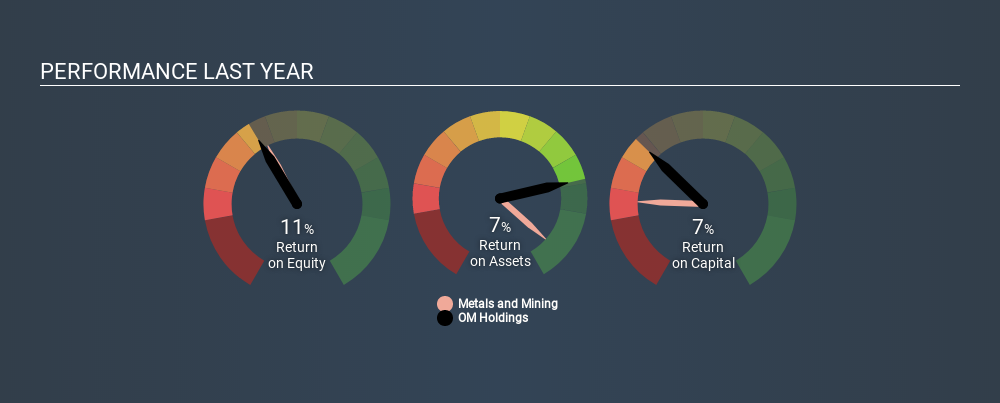Today we'll look at OM Holdings Limited (ASX:OMH) and reflect on its potential as an investment. Specifically, we'll consider its Return On Capital Employed (ROCE), since that will give us an insight into how efficiently the business can generate profits from the capital it requires.
First, we'll go over how we calculate ROCE. Then we'll compare its ROCE to similar companies. Last but not least, we'll look at what impact its current liabilities have on its ROCE.
Understanding Return On Capital Employed (ROCE)
ROCE is a measure of a company's yearly pre-tax profit (its return), relative to the capital employed in the business. All else being equal, a better business will have a higher ROCE. Ultimately, it is a useful but imperfect metric. Author Edwin Whiting says to be careful when comparing the ROCE of different businesses, since 'No two businesses are exactly alike.
How Do You Calculate Return On Capital Employed?
The formula for calculating the return on capital employed is:
Return on Capital Employed = Earnings Before Interest and Tax (EBIT) ÷ (Total Assets - Current Liabilities)
Or for OM Holdings:
0.065 = AU$64m ÷ (AU$1.2b - AU$220m) (Based on the trailing twelve months to December 2019.)
Therefore, OM Holdings has an ROCE of 6.5%.
See our latest analysis for OM Holdings
Is OM Holdings's ROCE Good?
ROCE is commonly used for comparing the performance of similar businesses. We can see OM Holdings's ROCE is meaningfully below the Metals and Mining industry average of 9.8%. This performance could be negative if sustained, as it suggests the business may underperform its industry. Separate from how OM Holdings stacks up against its industry, its ROCE in absolute terms is mediocre; relative to the returns on government bonds. Readers may find more attractive investment prospects elsewhere.
We can see that, OM Holdings currently has an ROCE of 6.5% compared to its ROCE 3 years ago, which was 1.4%. This makes us think about whether the company has been reinvesting shrewdly. You can see in the image below how OM Holdings's ROCE compares to its industry. Click to see more on past growth.

Remember that this metric is backwards looking - it shows what has happened in the past, and does not accurately predict the future. Companies in cyclical industries can be difficult to understand using ROCE, as returns typically look high during boom times, and low during busts. ROCE is only a point-in-time measure. Remember that most companies like OM Holdings are cyclical businesses. You can check if OM Holdings has cyclical profits by looking at this free graph of past earnings, revenue and cash flow.
OM Holdings's Current Liabilities And Their Impact On Its ROCE
Liabilities, such as supplier bills and bank overdrafts, are referred to as current liabilities if they need to be paid within 12 months. Due to the way ROCE is calculated, a high level of current liabilities makes a company look as though it has less capital employed, and thus can (sometimes unfairly) boost the ROCE. To counteract this, we check if a company has high current liabilities, relative to its total assets.
OM Holdings has current liabilities of AU$220m and total assets of AU$1.2b. Therefore its current liabilities are equivalent to approximately 18% of its total assets. This is a modest level of current liabilities, which would only have a small effect on ROCE.
The Bottom Line On OM Holdings's ROCE
If OM Holdings continues to earn an uninspiring ROCE, there may be better places to invest. You might be able to find a better investment than OM Holdings. If you want a selection of possible winners, check out this free list of interesting companies that trade on a P/E below 20 (but have proven they can grow earnings).
There are plenty of other companies that have insiders buying up shares. You probably do not want to miss this free list of growing companies that insiders are buying.
Love or hate this article? Concerned about the content? Get in touch with us directly. Alternatively, email editorial-team@simplywallst.com.
This article by Simply Wall St is general in nature. It does not constitute a recommendation to buy or sell any stock, and does not take account of your objectives, or your financial situation. We aim to bring you long-term focused analysis driven by fundamental data. Note that our analysis may not factor in the latest price-sensitive company announcements or qualitative material. Simply Wall St has no position in any stocks mentioned. Thank you for reading.
About ASX:OMH
OM Holdings
An investment holding company, engages in mining, smelting, trading, and marketing manganese ores and ferroalloys worldwide.
Excellent balance sheet and good value.
Similar Companies
Market Insights
Community Narratives



